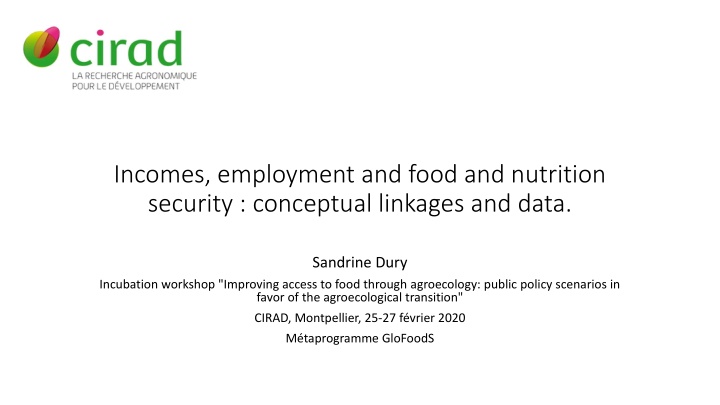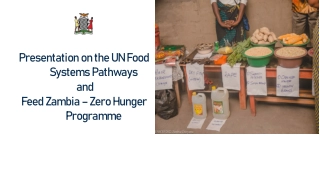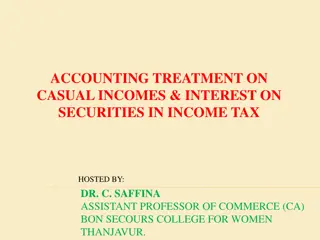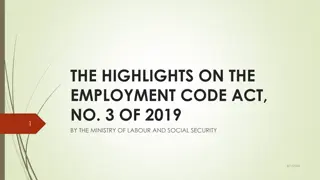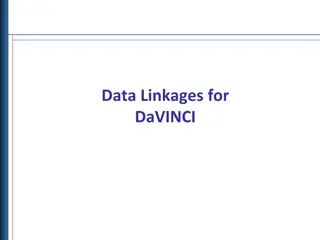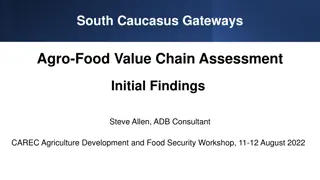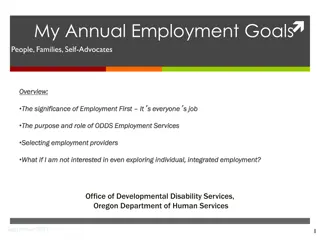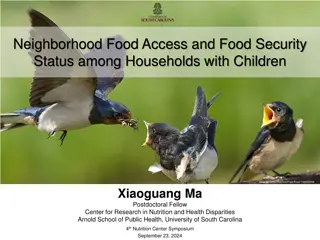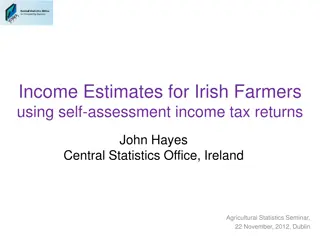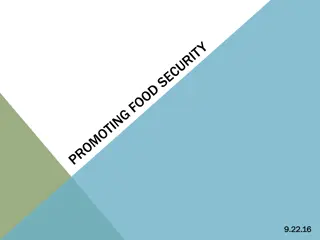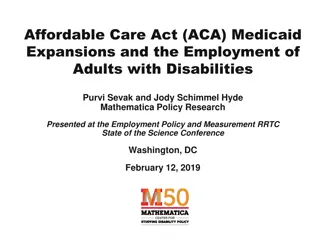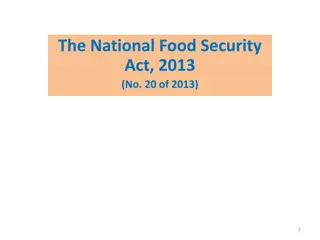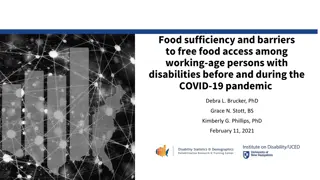Linkages between Incomes, Employment, and Food Security
This content explores the conceptual linkages between incomes, employment, and food security, highlighting public policy scenarios for an agroecological transition. Presented at an incubation workshop, the discussion focuses on improving food access through agroecology. The program, GloFoodS, delves into strategies for enhancing food and nutrition security.
Download Presentation

Please find below an Image/Link to download the presentation.
The content on the website is provided AS IS for your information and personal use only. It may not be sold, licensed, or shared on other websites without obtaining consent from the author.If you encounter any issues during the download, it is possible that the publisher has removed the file from their server.
You are allowed to download the files provided on this website for personal or commercial use, subject to the condition that they are used lawfully. All files are the property of their respective owners.
The content on the website is provided AS IS for your information and personal use only. It may not be sold, licensed, or shared on other websites without obtaining consent from the author.
E N D
Presentation Transcript
Incomes, employment and food and nutrition security : conceptual linkages and data. Sandrine Dury Incubation workshop "Improving access to food through agroecology: public policy scenarios in favor of the agroecological transition" CIRAD, Montpellier, 25-27 f vrier 2020 M taprogramme GloFoodS
higher income = more and better food, improvement in food and nutrition security At very low level of income, positive link between monetary income and access to calories. Definition of the extreme Poverty line = monetary threshold to have access to minimum calories and other basic needs to survive- Africa ++ and Asia. Big numbers = today 800 million poor and 800 million undernourished (based on food availability compared with energy requirement). High probability but not necessary the same households or persons.
Mali : lsms 2001. 8000 Households Poverty and calorie intake poor Non poor Caloric availability 8000 Poor with adequate caloric intake Non poor with adequate caloric intake : 27% 6000 conso_an 11% 4000 2000 Non poor with inadequate caloric intake 24% 0 0 100000 200000 300000 deptan Per capita expenditure Poor with in adequate caloric intake: 38% Bocoum I, et al 2014. Food Security.
FIES : Food Insecurity Experience Scale by country level of income (SOFI, 2019)
higher income = more and better food, improvement in food and nutrition security. Yes, but many exceptions. Food is not the top priority even for very poor people : Poor households do not always use extra money for food : they prefer other expenses (school, transport, cigarettes, social). Examples in Peru (fair trade, these Ninon Sirdey), in India (Duflo, Dreze & Deaton), in Mali (Ibrahima Bocoum); Priorities : investment in future (school fees) , in solidarities, in housing .
higher income = more and better food, improvement in food and nutrition security. Yes, but many exceptions. Households members have different preferences, face different constraints : the repartition (of access rights to) income in between the different hh members have a great influence on hh expenses (women food). More income for women might be, in certain cases, also synonymous with less available time for cooking and caring, and worse food and nutrition outcomes for those who depend more on family meals (infants, children, elder, ) -> look at the conditions of women s employment.
higher income = more and better food, improvement in food and nutrition security. Yes, but many exceptions. Low prices of low quality food products other Non Communicable Diseases. pandemic of obesity + diabetes +
Multiple burden of malnutrition heavier in Poor income countries Constraints of the food environment : good quality, tasty and affordable food products are not available for many households (urban or rural).
Data ? LSMS : The Living Standards Measurement Study (LSMS) is a household survey program by the World Bank's Development Data Group that provides technical assistance to national statistical offices in the design and implementation of multi-topic household surveys. livelihoods, expenditure, demography, agriculture, gender . Large sample representative of the population of the country; representative by strata (region, urban/rural). High frequency. Large coverage. (in terms of countries) Efforts convergence with agricultural statistics
LSMS specific programs LSMS + : gender equality Global Rural and Agricultural Integrated Surveys (GRAInS) p + AGRIS
MALI : The data from Enqute Agricole de Conjoncture Intgre 2014 (EAC-I 2014) LSMS ISA : Enqu te Agricole de Conjoncture Int gr e aux Conditions de Vie des M nages 2017 (EAC-I 2017) First round : 8398 households ; Second round : 3818 hh. Burkina Faso : The data from the 2014 Enqu te Multisectorielle Continue are now available for downloading free of charge. Vietnam : household living standard surveys VHLSS : since 2002 every two years . 8400 hh Household Income Sources : brief http://surveys.worldbank.org/publications/mali- eac-i-2017-household-income-sources Trinh Thi H, Simioni M, Thomas-Agnan C, 2018. World Development.
Are agro-ecological approaches able to re-design the food environments of poor/vulnerable people, urban and rural ? Through the production of good quality, affordable products for those specific people the creation and distribution of incomes between and inside households, to reduce food inequalities ?
